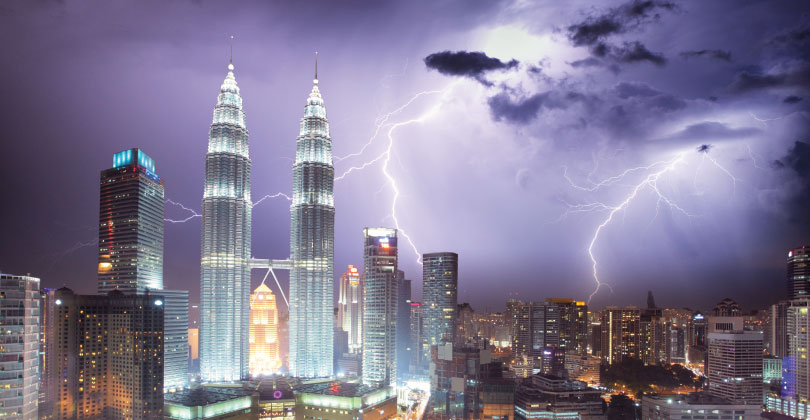In an era where electrical systems are an integral part of our daily lives, ensuring their safety and reliability is paramount. One of the often-overlooked aspects of electrical safety is Earthing and Lightning Protection (ELP). Did you know that in Malaysia, lightning strikes are a frequent event owing to its tropical climate and geographical location. The thunderstorms in Malaysia are not only spectacular but also intense and occur frequently. For instance, the Klang Valley experiences an average of 240 thunderstorm days per year.
The Shocking Reality: Lightning’s Dangers
Lightning is a powerful natural phenomenon caused by the buildup of electrical charges within clouds. When these charges become imbalanced, they seek to equalize, resulting in a lightning strike. This discharge can carry millions of volts of electricity and reach temperatures hotter than the surface of the sun. The sheer energy released during a lightning strike can wreak havoc on anything it encounters.
Lightning poses a myriad of dangers, from the immediate threat of electrocution to the indirect risks associated with power surges and fires. A direct lightning strike to a structure can cause fires, structural damage, and even fatalities. Indirect effects include electrical surges that can damage sensitive electronic equipment, disrupt power supply, and lead to data loss.
To minimise the damage caused by lightning strikes and power surges, proactive measures are essential. This is where Earthing and Lightning Protection (ELP) comes into play.
The Role of Earthing in Electrical Safety
Earthing, also known as grounding, is a fundamental component of electrical safety. It provides a pathway for excess electrical energy, such as from a lightning strike or power surge, to safely dissipate into the ground. Without proper earthing, this energy can follow unintended paths, leading to catastrophic consequences.
Surge Protective Devices (SPDs)
Surge Protective Devices (SPDs) are the unsung heroes of ELP. These devices are designed to detect voltage spikes and divert excess voltage safely to the ground. By doing so, SPDs protect sensitive electrical equipment and systems from damage during power surges. They act as a first line of defence against the destructive power of lightning.
Best Practices for Implementing ELP
Implementing an effective ELP system involves a combination of strategies and technologies:
- Risk Assessment: Begin by assessing the risk of lightning strikes and power surges in your area. Factors like geographical location and the nature of your electrical systems play a role in determining the level of protection required.
- Surge Protection: Install Surge Protective Devices (SPDs) at key points in your electrical system, such as main distribution panels and sensitive equipment. Ensure these devices are properly rated and regularly inspected.
- Earthing Systems: Establish a robust earthing system that complies with industry standards. This includes grounding conductors and earth rods designed to safely dissipate electrical energy into the ground.
- Maintenance: Yearly inspection of your ELP system. Connections should be in a good-shape, and SPDs should be replaced if they have absorbed a significant surge.
- Education: Train personnel and occupants on lightning safety procedures. This includes knowing what to do during a lightning storm, such as staying indoors and avoiding contact with conductive materials.
- Compliance: Ensure your ELP system complies with relevant industry standards and local regulations. Non-compliance can compromise safety.
- Continuous Monitoring: Consider implementing an ELP monitoring system that can detect electrical anomalies and trigger protective measures automatically.


